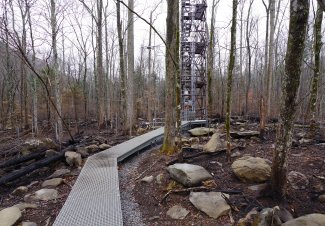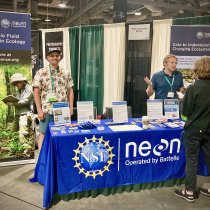NEON’s Great Smoky Mountains data will capture Tennessee fire impacts on local ecology
December 20, 2016
In mid-November 2016, a forest fire started in Great Smoky Mountains National Park, sparking several wildfires that spread uncontrollably throughout the park and into the nearby town of Gatlinburg. The Chimney Top 2 fire caused major destruction that included homes and businesses as well as fatalities and injuries. Over 10,000 acres of Great Smoky Mountains National Park burned including the area in which two NEON field sites are located.

Fire damage from Tennessee Fire at GRSM
In early December, a safety team returned to both field sites -- terrestrial site Great Smoky Mountains, Twin Creeks (GRSM) and aquatic site LeConte Creek (LECO) to assess the damage. The majority of the groundcover and litterfall were completely burnt, and 6-foot scorch marks on the trees indicated that the fire burned close to the ground compared to other nearby areas of the park in which the fire crowned the trees. Miraculously, the meteorological station, surface water sensors and groundwater sensors at LeConte Creek were unscathed. Similarly, the flux tower at the Great Smoky site suffered little to no heat exposure.
Melting caused by fire damage on a soil sensor array at Great Smoky Mountains field site from the 2016 wildfires.
However, soil sensors in the ground were extensively damaged from the intense heat of the fire. From a scientific perspective, the impact around these sites may prove to be a powerful opportunity for scientific study of how ecological communities will re-establish in an area which has seen very few wildfires in the last century. NEON data can also provide unique insight into what these communities looked like before the fire.
Great Smoky data
NEON began data collection activities at LeConte and Great Smoky in 2015, when the Airborne Observation Platform (AOP) was flown over both sites collecting lidar, hyperspectral and high resolution RGB ortho-photos of the surrounding vegetation and landscape. The sites were flown again in the summer of 2016 at peak greenness. The plan is to continue flying these sites annually. Click here to request the airborne remote sensing data from these field sites. In addition, observational sampling began in 2015 at the Great Smoky site. Field scientists were able to collect two full seasons of organismal and biogeochemical data. Some automated atmospheric and aquatic sensors began to collect data only weeks before the fire began.
All the data are freely available and NEON infrastructure resources can also be made available on a cost reimbursable basis to support proposed research efforts. Please note that much of the automated sensor data and observational data collected at these two sites has not been completely processed. The data should become available in the next year via the data portal.
Using NEON for long-term investigations of ecological change
Several years ago, in the wake of the High Park, CO wildfire of 2012, researchers from Colorado State University received an NSF RAPID Grant to collaborate with NEON to fly the AOP over the 87,000 acre burn area for a multi-year investigation. This use of NEON resources illustrates how the NEON research platform may be used to support long-term investigations of ecological change. Fast forwarding to today, we plan to get our Great Smoky field sites up and running as soon as possible so that we may continue to collect data via automated sensors, observational sampling and airborne remote sensing sampling. In addition, we have recently formalized a process for investigators to request observatory assets like the AOP to support research investigations. Learn more about the Assignable Assets program.
Community impacts
NEON field sites are managed by Battelle in collaboration with site hosts that grant us permission to construct and monitor instrumentation as well as conduct observational sampling on their land. Day-to-day, our dedicated field staff and related site host staff often come across dangerous situations from extreme weather to dangerous animals. And then there are major and unexpected risks such as wildfires and floods. Our thoughts and condolences go out to the families in the Great Smoky area, like our site hosts, who were greatly impacted by the Tennessee wildfires. We greatly value the partnership we have with Great Smoky Mountains National Park. It is our hope that the long-term data collected by observation systems like NEON will be used to mitigate wildfire impacts on both the ecosystems around us and the communities where we live. If you are interested in contributing to relief efforts for the families and businesses of Gatlinburg, here is some information.

